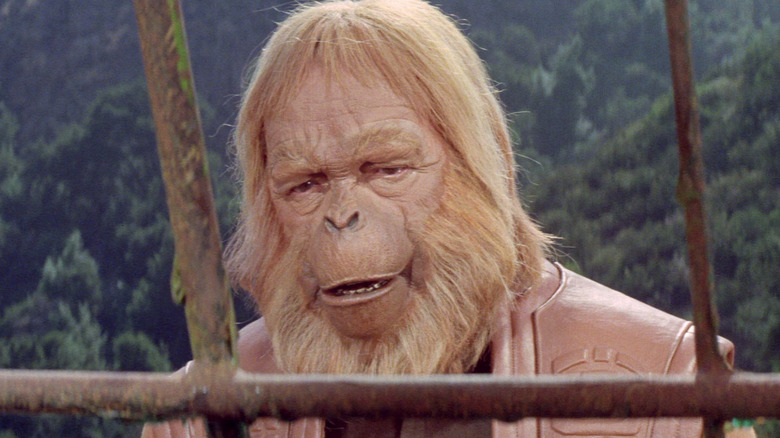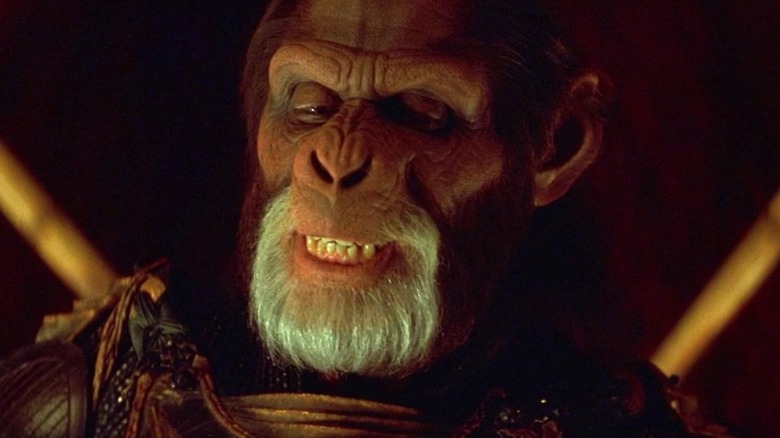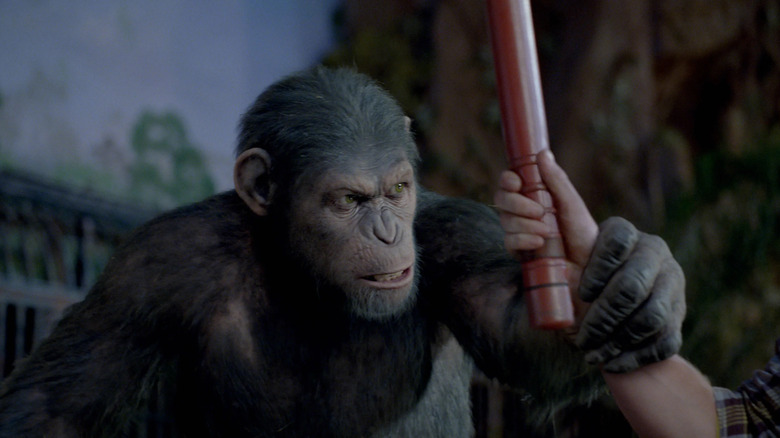The Correct Order To Watch The Planet Of The Apes Movies
Franklin J. Schaffner's 1968 sci-fi classic "Planet of the Apes," written by Michael Wilson and Rod Serling, is a perfectly wicked political satire set in a distant, distant future on a distant, distant planet wherein human-like beings live as mute brutes and apes (chimpanzees, gorillas, and orangutans) have evolved into the dominant rulers of the planet. The planet is discovered by a group of Earth astronauts who flew through some sort of time vortex while in the outer cosmos, and their leader, the stalwart Taylor (Charlton Heston), finds himself having to prove to the planet's own apes that humans are indeed capable of speech and thought.
In one of the best-known twist endings in cinema history, the film ultimately reveals that the planet of the apes was Earth all along. Taylor discovers a millennia-old Statue of Liberty on a distant beach, realizing that humans destroyed themselves in a nuclear conflagration and that apes evolved in their place. No doubt it was Serling, the mastermind behind "The Twilight Zone," who conceived of such a twist, proving that humanity's incessant need to start wars and explode nuclear bombs was going to be met with a grim future. Humans, he notes, will become mere cavemen held in the thrall of a species they once considered themselves superior to. Hubris, thy name is man.
Although Schaffner's film is complete unto itself, it was a massive hit and spawned multiple sequels and remakes explaining more about the "Apes" mythos than was really necessary. The sequels would also introduce time travel and weird causality loops just to answer the question as to how apes came to evolve from humans. A newer rebooted "Apes" series has since walked audiences through that process more slowly.
Here's a list of the "Apes" movies in the order of their release.
The release order
There are, as of this writing 10 extant "Apes" movies. In order, they are:
- Franklin J. Schaffner's "Planet of the Apes" (1968)
- Ted Post's "Beneath the Planet of the Apes" (1970)
- Don Taylot's "Escape from the Planet of the Apes" (1971)
- J. Lee Thompson's "Conquest of the Planet of the Apes" (1972)
- J. Lee Thompson's "Battle for the Planet of the Apes" (1973)
- Tim Burton's "Planet of the Apes" (2001)
- Rupert Wyatt's "Rise of the Planet of the Apes" (2011)
- Matt Reeves' "Dawn of the Planet of the Apes" (2014)
- Matt Reeves' "War for the Planet of the Apes" (2017)
- Wes Ball's "Kingdom of the Planet of the Apes" (2024)
In 1974, there was an in-universe TV series called "Planet of the Apes," which was set about 900 before the events of the first movie. There was also a non-canonical animated series in 1975 called "Return to the Planet of the Apes" made by the same company that put out "Jonny Quest."
The "Apes" films released between 1968 and 1973 follow a single (if convoluted) continuity. In "Beneath," Taylor discovers a tribe of subterranean psychic mutants who worship an unexploded nuclear bomb. Taylor eventually decides to set off the bomb and destroy the world. In "Escape," it is revealed that three apes escaped the explosion and traveled back in time to the then-present-day Earth. "Escape" also posits that an Ape child will essentially accelerate the rise of Apes on Earth, leading to the events of the first movie. "Conquest" fast-forwards a few decades and finds the Ape child grown up and leading an Ape rebellion. After that, "Battle" fast-forwards another few decades and shows Apes moving into a place of power after a nuclear armageddon.
It's hardly clean, but it's entertaining.
The other ape continuities
The 2001 "Planet of the Apes" remake stands in a continuity all its own and tells a different story than the 1968 original. In that film, an astronaut (Mark Wahlberg) flies through a portal and is deposited on a planet of apes who rule over the native human population. Unlike in the original film, however, humans are intellectual beings who are captured and enslaved by the talking apes. There is also some time-travel rigmarole that doesn't stand up to much scrutiny. The most notable elements of Burton's film are its visuals. The ape makeup may be some of the best in cinema history, a fitting distinction given that the ape makeup from the 1968 original was similarly celebrated (it received a special Academy Award for its makeup effects).
"Rise of the Planet of the Apes" swapped the makeup for motion-capture CGI, allowing for photorealistic ape faces to directly match those of their human actors. "Rise" and its first two sequels have essentially spun out a narrative that re-tells the events of "Conquest of the Planet of the Apes," detailing how Apes came to rise in the first place. In "Rise," it's explained that an advanced, gaseous virus has been released by the chimpanzee Caesar (Andy Serkis). The virus increases Ape intelligence but is deadly to humans. "Dawn" and "War" take place after the virus wipes out much of humanity and mutates, leaving infected humans with reduced cognitive abilities and speech loss.
There was a time when one might be able to squint and pretend that "Rise" was in the same continuity as the 1968 original (there is even a reference to the spacecraft the Charlton Heston character flew into space). However, its follow-ups negate that theory.
"Kingdom of the Planet of the Apes" arrives on May 10, 2024.


